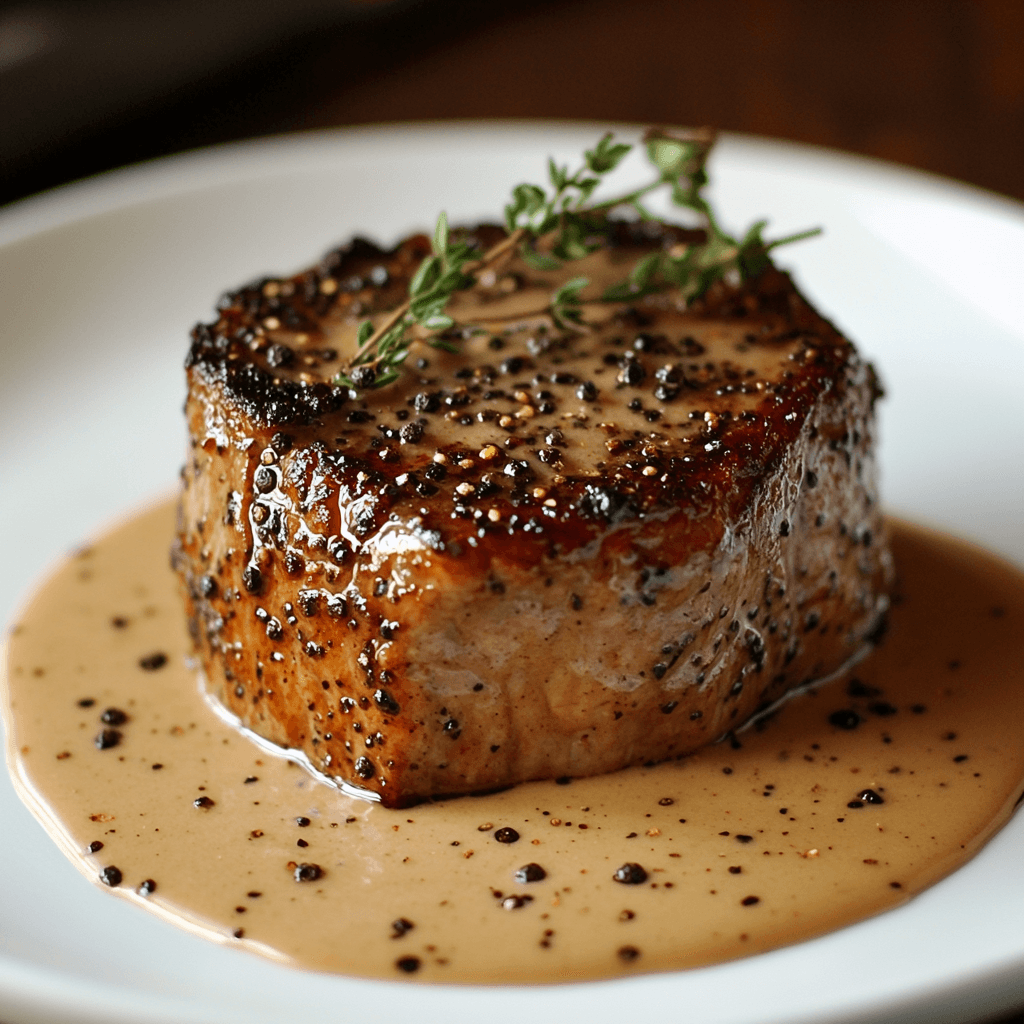Table of Contents
I’ll never forget the first time I attempted Gordon Ramsay Steak Au Poivre in my own kitchen. After years of putting out fires as a firefighter, I thought I could handle a little flame from the cognac. Wrong. The sauce broke, the peppercorns burned, and I nearly set off the smoke alarm. That disaster taught me that mastering Gordon Ramsay Steak Au Poivre demands respect, precision, and the right techniques to achieve restaurant-quality results at home.
Why This Recipe Works (And Where Most Go Wrong)
The magic of a perfect Gordon Ramsay Steak Au Poivre lies in understanding three critical principles that separate restaurant-quality results from home kitchen disasters. First, the peppercorn crust must be properly adhered to the meat before cooking – most people simply sprinkle peppercorns on top, only to watch them fall off and burn in the pan. Second, the temperature control during sauce creation is crucial; too high and the cream will break, too low and it won’t properly emulsify with the pan drippings.
The most common mistake I see home cooks make when preparing Gordon Ramsay Steak Au Poivre is rushing the process. This signature dish requires patience and proper timing. The steaks need to rest at room temperature, the peppercorns need to be properly crushed (not ground), and the sauce needs careful attention to achieve that silky, restaurant-quality finish. When you follow the proper technique for cooking tender cuts, similar principles apply to achieving perfect doneness every time.
According to the USDA’s safe temperature guidelines, steaks should reach a minimum internal temperature of 145°F for safety, though for steak au poivre, most prefer the 130°F range for medium-rare perfection.
Ingredients That Actually Matter
Not all steaks are created equal for Gordon Ramsay Steak Au Poivre, and your choice of cut will make or break this dish. Filet mignon remains the gold standard for steak au poivre – its tender texture and mild flavor allow the peppercorn and cognac sauce to shine without competing flavors. However, if you’re looking for alternatives to expensive cuts, consider a well-marbled strip steak or even a properly aged ribeye.
The peppercorns deserve special attention when crafting Gordon Ramsay Steak Au Poivre. Freshly cracked black peppercorns provide the signature bite and aroma that defines this dish. Pre-ground pepper simply won’t deliver the same intensity or texture. I always keep whole peppercorns specifically for this recipe, crushing them with the flat side of my knife just before cooking.
For the sauce, quality cognac makes a noticeable difference, though a good brandy works perfectly well. The heavy cream should be at room temperature to prevent shocking when added to the hot pan, and real butter – not margarine – provides the silky finish that elevates this sauce from good to extraordinary.
Step-by-Step Instructions
Critical Warning: Always remove the pan from heat before adding alcohol to prevent dangerous flare-ups.
Start by bringing your steaks to room temperature, about 30 minutes on the counter. This ensures even cooking throughout. While they’re tempering, coarsely crush your peppercorns – you want irregular pieces, not fine powder. The texture should be chunky enough to provide bite but not so coarse that it’s unpleasant to eat.
Season the steaks generously with salt, then firmly press the crushed peppercorns into both sides. This pressing action is crucial – you want those peppercorns embedded in the meat, not just sitting on top. Heat your oil in a heavy-bottomed skillet over medium-high heat until it shimmers but doesn’t smoke.
Place the steaks in the pan and resist the urge to move them. Let them develop a proper crust – about 3-4 minutes for the first side. Flip once and cook another 3-4 minutes for medium-rare. Use a meat thermometer to check for 130°F internal temperature.
Remove the steaks to rest under a foil tent – this step is non-negotiable for juicy results. In the same pan, reduce heat to medium and add butter along with your minced shallot. Cook until fragrant, about one minute.
Here’s where technique matters most: remove the pan completely from heat before adding the cognac. It may flame briefly, which is normal, but you want control over this process. Return to heat and let the alcohol cook off for about 30 seconds before adding the cream and mustard.
Pro-Tips That Change the Game
- Room temperature steaks cook more evenly – never skip this 30-minute window
- Press peppercorns firmly into the meat – gentle sprinkling leads to burned peppercorns on the pan bottom
- Use the same pan for the sauce – those fond bits are flavor gold
- Remove pan from heat before adding alcohol – safety first, always
- Strain the sauce if serving guests – removes any stray peppercorn pieces for elegant presentation
- Add a touch of Dijon mustard – it helps emulsify the sauce and adds subtle depth
- Let steaks rest properly – cutting too early releases all those precious juices
Storage & Leftovers Guidance
Steak au poivre is best enjoyed immediately, but leftovers can be stored in the refrigerator for up to 3 days. The key to reheating is gentleness – never use high heat or you’ll end up with overcooked, tough meat. I recommend slicing leftover steak and gently warming it in the sauce over low heat.
The sauce can be made ahead and stored separately for up to 2 days. When reheating, whisk in a splash of cream or stock to restore the proper consistency. If the sauce has separated, a quick blend with an immersion blender usually brings it back together.
For meal prep enthusiasts, you can prepare the peppercorn-crusted steaks up to 4 hours ahead and keep them refrigerated. Just remember to bring them back to room temperature before cooking.

Gordon Ramsay Steak Au Poivre
Ingredients
Equipment
Method
- Remove steaks from refrigerator 30 minutes before cooking to bring to room temperature.
- Coarsely crush peppercorns using the flat side of a knife or rolling pin.
- Season steaks generously with salt, then press crushed peppercorns into both sides.
- Heat oil in heavy-bottomed skillet over medium-high heat until shimmering.
- Add steaks and cook 3-4 minutes per side for medium-rare (130°F internal temperature).
- Remove steaks to rest under foil tent for 5 minutes.
- Reduce heat to medium, add butter and shallot to same pan, cook 1 minute.
- Remove pan from heat, add cognac (it may flame briefly).
- Return to heat, add cream and mustard, simmer until thickened, 2-3 minutes.
- Taste sauce and adjust seasoning, strain if desired.
- Serve steaks immediately with sauce spooned over top.
Nutrition
Notes
Don’t skip the peppercorn pressing step – it prevents them from falling off
Use a meat thermometer for perfect doneness every time
Cognac can be substituted with brandy or even beef stock if preferred
Sauce can be made ahead and reheated gently
Tried this recipe?
Let us know how it was!Comprehensive FAQ Section
What is the best cut of steak for steak au poivre?
Filet mignon is the traditional and best choice for steak au poivre due to its tender texture and mild flavor that doesn’t compete with the peppercorn sauce. The cut’s tenderness allows the bold flavors to shine while maintaining that melt-in-your-mouth quality that defines restaurant-quality steak au poivre.
What sauce does Gordon Ramsay use for steak?
Gordon Ramsay’s steak au poivre sauce combines cognac, heavy cream, and Dijon mustard with the pan drippings from the seared steaks. The key is deglazing the pan with cognac first, then adding cream and a touch of mustard to create that signature silky, peppercorn-infused sauce that coats the back of a spoon.
What is the difference between steak diane and steak au poivre?
The main difference lies in the sauce and seasoning. Steak au poivre features a prominent peppercorn crust and cognac cream sauce, while steak diane typically uses a brandy-based sauce with Worcestershire sauce, mustard, and herbs, without the signature peppercorn coating.
What is au poivre sauce made of?
Au poivre sauce is made from pan drippings, cognac or brandy, heavy cream, and often includes Dijon mustard for emulsification. The sauce gets its distinctive flavor from the peppercorns that have been seared with the steak, creating a rich, creamy base that’s both spicy and luxurious.
What does “au poivre” mean in French?
“Au poivre” literally translates to “with pepper” in French, referring to the generous coating of cracked black peppercorns that creates the dish’s signature spicy crust and flavor profile.
How does Gordon Ramsay tenderize steak?
Gordon Ramsay relies on proper technique rather than marinades for tender steak – using room temperature meat, proper seasoning timing, high-heat searing for caramelization, and most importantly, allowing the meat to rest after cooking to redistribute juices throughout the fibers.
This steak au poivre recipe embodies the same principles I learned during my firefighting days – preparation, timing, and respect for the process. When you master these fundamentals, you’ll create restaurant-quality results that would make any French chef proud. The combination of perfectly seared steak, aromatic peppercorns, and that luxurious cognac cream sauce represents everything great about classic French cuisine.
Much like perfecting Gordon Ramsay’s garlic bread requires attention to detail, this steak au poivre demands your full attention and respect for each step. The reward is a dish that transforms a simple dinner into a memorable dining experience.
Stay safe, Jack Sullivan


